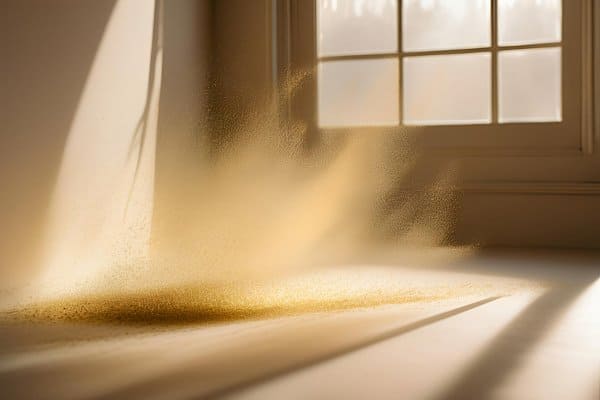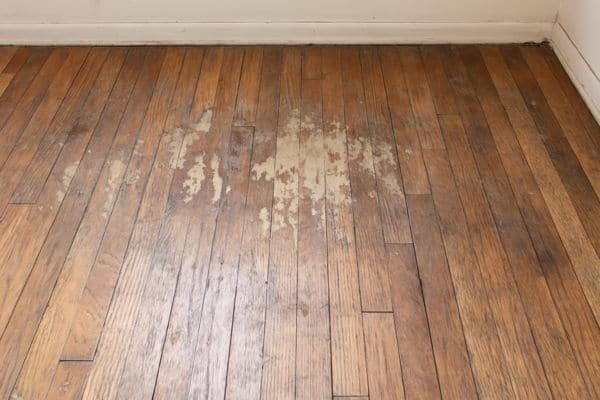You could swear you just cleaned—but there it is again. That stubborn layer of dust, casually reclaiming your nightstand like it pays rent. It’s enough to make anyone wonder: why does your room get so dusty, so fast?
While things like open windows or nearby roadwork might be easy to blame, the truth is, dust has a sneaky way of showing up—even when you’re doing everything “right.” Bedrooms are especially guilty, thanks to cozy fabrics, poor airflow, and all the skin and hair we unknowingly shed during sleep.
And it’s not just a visual annoyance. Dust buildup affects air quality, sleep, and allergies. According to the EPA, the average American home collects up to 40 pounds of dust each year. That’s more than enough to stir up concern.
So what’s really causing it—and how do you stop it from coming back? Let’s get into it.
What Is Dust Made Of? (And Why It Keeps Coming Back)

You might think that indoor dust blows in from outside, but most of it is actually coming from inside your home.
That light film you keep wiping off your shelves? It’s a cocktail of everyday particles made right where you live.
At its core, dust is a mix of dead skin cells, pet dander, hair, pollen, fabric fibers, and even mold spores.
Every time you lounge on the couch, walk across a rug, or fluff your throw pillows, you’re releasing tiny airborne particles into the room. Your skin naturally sheds, your clothes and bedding fibers break down, and your pets add their own contribution with fur and dander.
Even simple activities like moving around, opening the door, or breathing can stir up more dust.
It’s not just what’s coming in—it’s what you’re constantly generating. And while shoes can track in pollen and dirt from a busy street or nearby construction sites, it’s the stuff indoors that keeps the cycle going.
Here’s where it gets trickier—dust mites.
These microscopic critters feed on the organic bits floating around your room, like dead skin flakes and other particles. Their droppings then become part of the dust themselves, turning one layer of dust into a breeding ground for the next.
Unless you actively remove dust particles and trap dust using proper cleaning techniques, this cycle just keeps repeating. That’s why regular cleaning with tools like a microfiber cloth or vacuum with a HEPA filter is essential.
Without it, your home won’t just look dusty—it’ll stay dusty.
Let’s look at the top reasons your room feels like a dust magnet—and what you can do to fix it.
7 Reasons Why Your Room Gets So Dusty (And How to Fix Each One)
1. Poor Ventilation or Airflow

If your room feels like it’s always wearing a dusty coat, your air might be to blame.
Stale, unmoving air is one of the biggest culprits behind dust buildup. It lets airborne dust settle quietly onto your furniture, shelves, and floors—no breeze to carry it out, just layer after layer collecting in silence.
Now think about your ceiling fan.
Whether it’s on or off, those blades attract dust like magnets—and if you never clean them, they’ll just blow dust right back into the air. And let’s not forget your air conditioner.
If you haven’t changed that AC filter in a while, you’re likely circulating dust instead of filtering it, which emphasizes the importance of air filters.
When air doesn’t move, your room becomes a dust collector. Closed windows, blocked vents, and rarely used rooms all create the perfect environment for dust accumulation.
According to the EPA, poorly ventilated rooms can have two to five times more indoor pollutants than those with good airflow.
Fix it:
Crack a window open for 15–30 minutes a day if the outdoor air quality is safe. Let your space breathe.
Run your ceiling fans occasionally to keep air circulating—and don’t forget to wipe those fan blades with a damp microfiber cloth now and then.
Swap out your HVAC filters regularly to help trap dust and improve indoor air quality.
Adding an air purifier to the mix? Even better. A good one with a high-efficiency particulate air (HEPA) filter can significantly reduce airborne particles.
2. Dirty or Infrequently Changed HVAC Filters
Ever feel like no matter how often you dust, the air itself seems to be working against you? You might want to check what’s hiding behind your vents.
Your HVAC system is supposed to help with indoor air quality—but when the filters are clogged, it can turn into a full-time dust distributor.
Air filters are designed to trap dust particles, pollen, pet dander, and other airborne debris. But once they’re full, they lose the ability to catch new particles.
Instead, they start blowing that trapped dust right back into your room every time the heat or AC kicks in. The result? More dust settles on your furniture, and in the air, you breathe.
This is especially noticeable in rooms closest to the intake vents, where the dust gets a front-row seat to the airflow. If you’ve got allergies or just want to reduce dust in your space, this is a non-negotiable fix.
Fix it:
Make a habit of replacing your HVAC filters every one to three months. If you live in a dust-prone area or have pets, monthly changes are your best bet.
For better results, go with HEPA-rated filters—they’re designed to trap finer particles and improve indoor air quality.
While reusable filters might seem eco-friendly, they don’t always perform well in homes with high dust levels. In this case, disposable filters might actually be the cleaner choice.
3. Fabric-Heavy Furnishings
Your room might look warm and cozy—but those soft layers could be a dust trap in disguise.
From thick rugs to plush throw pillows, fabric-heavy decor doesn’t just look inviting—it also invites dust to settle in and stick around.
Textiles like bedding, curtains, carpets, and upholstered furniture act like giant sponges for dust particles. Every time you sit on your couch or fluff a pillow, you’re releasing fibers, skin cells, and pet dander into the air.
Even your curtains can collect dust just by hanging there.
And if you’ve ever noticed a fine coating on decorative items like photo frames or souvenirs, it’s because intricate surfaces collect more dust than clean, simple ones—and they’re much harder to wipe down.
And here’s a fact that might make you want to strip your bed right now: over time, a king-size mattress can harbor up to 10 million dust mites. That’s a whole ecosystem of allergens living where you sleep.
Fix it:
Start with the basics—wash your bedding weekly in hot water to remove dust mites and dead skin cells.
Use a vacuum with a HEPA filter to clean rugs, carpets, and fabric furniture at least two to three times a week.
If your windows are dressed in thick curtains, consider switching to blinds or washable fabrics you can clean more often.
For a simple but effective prevention tip, place a doormat at your home’s entrance and keep a shoe rack nearby. A no-shoes policy can drastically cut down on the amount of dust, dirt, and pollen you track inside.
4. Pet Hair and Dander
They’re adorable, loyal, and your favorite cuddle buddies—but let’s be honest: your pets are probably turning your room into a dust factory.
Even short-haired breeds shed fur, skin, and pet dander that easily blends into indoor dust, especially in the places they love most—like your bed, the couch, or that cozy corner by the window.
Pet hair is visible, sure, but dander is microscopic and sneaky.
It clings to carpets, bedding, and upholstery, then gets stirred back into the air every time you sit down or walk by.
When mixed with other airborne particles like dust mite droppings or pollen, it can make allergy symptoms much worse—think sneezing fits, itchy eyes, and that annoying tickle in your throat.
Fix it:
Start with weekly washes for pet bedding, and vacuum their favorite hangouts regularly using a HEPA-filter vacuum to trap allergens before they float back into the air.
Brush your pets outdoors if the weather allows—it helps remove loose fur and dead skin flakes before they can settle indoors.
Bathing your pet more frequently (based on their breed and skin needs) can also reduce dander levels. For a quick fix between cleanings, keep a lint roller or a pair of rubber gloves handy to lift fur off furniture.
5. Clutter and Uncleaned Surfaces
If you’ve ever moved a stack of books or reached behind your TV console and discovered a mini dust storm, you already know: clutter is a dust magnet.
The more stuff you have sitting out—like picture frames, chargers, candles, or unused decor—the more surfaces you’re giving dust to settle on (and hide in).
It’s not just about what you can see.
Dust sneaks into forgotten corners, behind furniture, and underneath beds, silently building up until it starts affecting your indoor air quality.
For anyone with allergies or asthma, these uncleaned areas can make symptoms worse—especially when the dust gets stirred back up during daily movement.
Plus, clutter makes cleaning harder. Tangled cords, tightly packed shelves, and crowded desks all make it easier for dust to collect and harder for you to reach.
Fix it:
Start by decluttering high-dust zones—think nightstands, window sills, open shelving, and any surfaces layered with small items.
Less clutter means fewer places for dust to cling and more room for your vacuum or microfiber cloth to actually reach.
Make it a habit to dust with a slightly damp microfiber cloth instead of a dry feather duster (which just blows dust around).
Don’t forget the baseboards, the space under your bed, and behind heavy furniture—schedule a monthly deep clean to keep hidden dust under control.
6. Old or Poorly Maintained Flooring

Every time you take a step, your floor might be puffing up a little dust cloud you can’t even see.
While it’s easy to blame airborne particles or open windows, your flooring—especially if it’s older or neglected—could be quietly contributing to the problem.
Hardwood floors with cracks, gaps, or worn-out finishes can shed dust as the top layer deteriorates. Over time, the wood can splinter or collect dirt in crevices, especially if it hasn’t been sealed properly.
Even concrete floors, when unsealed, can break down and release fine dust particles into the air.
Then there’s carpet—a soft, cozy trap for dust. It holds onto pet hair, dead skin flakes, textile fibers, and more.
Fix it:
If you’ve got carpets, aim to steam clean them every 3 to 6 months and vacuum with a HEPA filter regularly.
That’ll help remove dust that gets buried deep in the fibers. For wood flooring, sweep and mop weekly, and make sure to use products designed for hardwood.
If your floors are old or visibly worn, consider sealing or refinishing them to prevent dust from building up in damaged areas.
Whether your home has sleek wood floors or wall-to-wall carpeting, keeping them in good condition is key to maintaining a dust-free environment.
7. Open Windows and Outdoor Debris
That fresh breeze rolling through your window? It might be carrying more than just cool air.
While airing out your room can feel refreshing, open windows—especially on windy or high-pollen days—are an open invitation for dust, pollen, and other airborne particles to waltz right in.
If you live near a busy street, construction site, or dusty yard, outdoor debris can easily find its way indoors.
Drafts under doors and gaps around windows make it even easier for microscopic particles to sneak in and settle on your surfaces. That fine layer of dust on your windowsill? It’s likely the result of just one breezy afternoon.
Fix it:
Before you throw open the windows, check your local air quality. Apps and weather sites usually offer real-time updates. On high-pollen or dusty days, it’s better to keep things sealed up.
Use window screens to help trap dust and prevent it from blowing straight in. Add a high-quality doormat outside your entrance to catch dirt before it reaches your floors, and consider sealing gaps under doors and around window frames with weather stripping.
Placing an air purifier near open windows or vents can also help capture airborne dust before it settles.
By managing what comes in from outside, you’ll reduce the amount of new dust—and make your cleaning efforts last a whole lot longer.
How to Reduce Dust Buildup Long-Term
You’ve tackled the usual suspects—but keeping your room dust-free isn’t just about fixing the obvious. It’s about building habits that stop new dust from creeping in day after day.
Because the truth is, dust isn’t a one-time cleanup—it’s a routine battle.
Whether you live with pets, love layered decor, or simply breathe (yes, even that adds to airborne dust), long-term control takes a consistent approach.
The good news? With the right tools and schedule, you can significantly reduce dust levels and enjoy a cleaner, healthier space year-round.
Here’s your go-to checklist for cutting down on dust long-term:
- Use HEPA air purifiers in high-traffic areas and bedrooms to capture fine dust particles and improve indoor air quality.
- Stick to a simple cleaning schedule:
- Dust surfaces weekly using a damp microfiber cloth (not a feather duster that just blows dust around).
- Vacuum carpets, rugs, and upholstered furniture 2–3 times a week using a HEPA-filter vacuum.
- Wash bedding and curtains every two weeks to remove dander, hair, and fabric fibers.
- Declutter regularly to reduce the number of items that attract and collect dust—especially on shelves, nightstands, and dressers.
- Replace old carpets that no longer respond to deep cleaning, especially if they’ve become a permanent home for dust mites and allergens.
- Keep pets groomed and their bedding washed weekly to prevent dander buildup.
- Seal window and door gaps to stop outdoor debris from sneaking in.
When these steps become part of your regular routine, you’ll notice not only less dust—but better sleep, fewer allergy symptoms, and a home that actually stays clean between deep cleans.
When should you stop scrubbing and call in the professionals? Let’s talk about when it’s time to bring in the dust-fighting experts.
When to Call in a Professional Cleaning Service

If you’ve vacuumed like a champ, wiped every surface twice, swapped out air filters, and yet your room still feels dusty… it might be time to take a break—and call in reinforcements.
Sometimes, no matter how diligent you are, layers of dust hide in places you simply can’t reach or clean effectively with household tools.
If your allergies are still flaring, there’s a musty smell that won’t go away, or dust keeps coming back fast, that’s your cue. Rooms that have recently undergone construction or renovations are especially prone to stubborn, deep-set dust accumulation.
Professional cleaners, like the team at Atlanta Maids, come equipped with commercial-grade vacuums, HEPA filters, and tools designed to eliminate dust from every nook and cranny. They can clean vents, baseboards, ceiling fans, and other hard-to-reach areas you probably haven’t touched since move-in day.
Plus, hiring a maid service isn’t just about the deep clean—it’s about getting a clean slate, literally. Once everything is properly reset, maintaining a dust-free environment becomes a whole lot easier.
So if your DIY routine just isn’t cutting it, let the pros handle it. You’ll breathe easier—and spend less time chasing dust bunnies.
Say Goodbye to Dust with Atlanta Maids
You’ve got enough on your plate—chasing dust around your room shouldn’t be one of them. Whether you’re tired of wiping the same shelf every two days or just want to breathe easier at night, Atlanta Maids is here to clear the air (literally).
We don’t just clean what’s visible—we dig deep, tackling the hidden dust that’s been camping out in your carpets, curtains, and baseboards. Our pros come armed with the right tools, sharp eyes, and zero tolerance for dust bunnies.
Ready to ditch the duster? Call us at (404) 905-5141, or skip the wait and book instantly: atlantamaids.com/booking-page
Let Atlanta Maids help you reclaim your space—and give your home the dust-free reset it’s been waiting for. One clean sweep, and it’s like the dust was never even there.
FAQs
Is it bad to sleep in a very dusty room?
Yes, sleeping in a dusty bedroom can affect your health and comfort. Dust particles and dust mite droppings can trigger allergies, irritate your skin, and disrupt your breathing while you sleep. If you wake up with a stuffy nose or itchy eyes, it may be time to deep clean and improve your indoor air quality with an air purifier or regular dusting.
Is it unhealthy to live in a dusty room?
Living in a room with excessive dust isn’t just annoying—it can be harmful. Indoor dust often contains pet dander, dead skin cells, pollen, and other airborne particles that can irritate allergies and worsen asthma symptoms. Poor airflow and improper cleaning habits only make dust accumulation worse. To stay healthy, reduce dust and maintain a clean, dust-free environment.
Is a dusty room bad for the lungs?
A dusty room can definitely be tough on your lungs, especially if you have asthma or other respiratory issues. When dust settles, it doesn’t stay put—walking, cleaning, or even breathing stirs up airborne dust that you end up inhaling. Long-term exposure can cause allergic reactions and breathing discomfort, so it’s essential to eliminate dust and improve indoor air.
Do air purifiers remove dust?
Yes, especially if they use a HEPA filter. A high-efficiency particulate air purifier can remove dust particles, pet hair, and other airborne dust from your room, improving your indoor air quality over time. Just remember: while air purifiers trap dust, they don’t clean surfaces—so pair one with regular cleaning for the best results.
Can Atlanta Maids help me get rid of dust?
Absolutely! Atlanta Maids specializes in removing both visible and hidden dust. From upholstered furniture to vents and baseboards, our team uses commercial-grade tools to trap dust and remove allergens at the source. Whether it’s a dusty bedroom or whole-home deep clean, we’ll leave your space feeling fresh, healthy, and dust free. Book a service online anytime!

